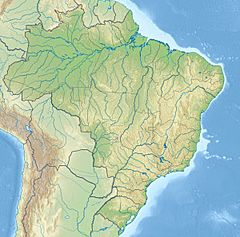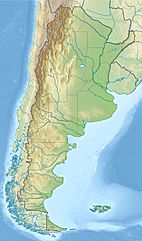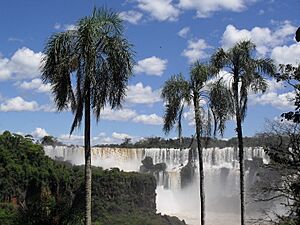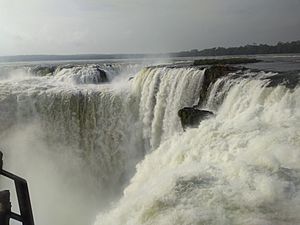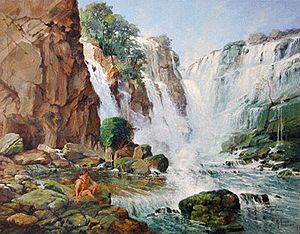Iguazu Falls facts for kids
Quick facts for kids Iguazú Falls |
|
|---|---|
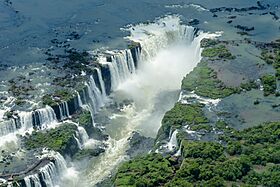 |
|
| Lua error in Module:Infobox_mapframe at line 185: attempt to index field 'wikibase' (a nil value). | |
| Location | Argentina: Misiones province Brazil: Paraná state |
| Coordinates | 25°41′12″S 54°26′41″W / 25.68667°S 54.44472°W |
| Number of drops | 275 |
| Longest drop | 82 metres (269 ft) |
| Watercourse | Iguazu River |
| Average flow rate |
1,756 m3/s (62,010 cu ft/s) |
The Iguazú Falls (also called Iguaçu Falls) are a huge system of waterfalls on the Iguazu River. They sit right on the border between Argentina and Brazil. These falls are so big, they make up the largest waterfall system in the whole world!
The Iguazu River starts near the city of Curitiba in Brazil. Most of the river flows through Brazil. However, most of the actual waterfalls are on the Argentine side. The falls split the river into two parts: the upper Iguazu and the lower Iguazu.
The name Iguazú comes from the Guarani language. It means "big water." There's an old legend about how the falls were made. A god wanted to marry a beautiful woman named Naipí. But she ran away with her human boyfriend, Tarobá, in a canoe. The god got super angry! He sliced the river, creating the waterfalls. This trapped the lovers in an endless fall.
The first European to see these amazing falls was a Spanish explorer named Álvar Núñez Cabeza de Vaca in 1541.
Contents
How the Falls Were Formed
The Iguazú Falls look like a giant staircase. They have two main steps made of three layers of basalt rock. These steps are about 35 and 40 metres (115 and 131 ft) tall. The rocks here are part of a huge, thick rock layer called the Serra Geral formation.
Many islands dot the 2.7-kilometre-long (1.7 mi) edge of the falls. These islands divide the water into many separate waterfalls. There can be anywhere from 150 to 300 smaller waterfalls. This number changes depending on how much water is flowing. The falls range from 60 to 82 m (197 to 269 ft) high.
About half of the river's water crashes into a deep, narrow canyon. This famous spot is called the Devil's Throat. In Spanish, it's Garganta del Diablo. In Portuguese, it's Garganta do Diabo. This canyon is about 80–90 m (260–300 ft) wide and 70–80 m (230–260 ft) deep.
The Iguazú Falls are shaped a bit like a reversed letter "J". The border between Argentina and Brazil runs right through the Devil's Throat. Brazil has most of the Iguazu River basin. But Argentina has almost 80% of the actual waterfalls!
Visiting Iguazú Falls
You can reach the falls from two main towns. One is Foz do Iguaçu in Brazil. The other is Puerto Iguazú in Argentina. You can also get there from Ciudad del Este in Paraguay. All three cities have airports.
The falls are part of two national parks. These are the Iguazú National Park in Argentina and the Iguaçu National Park in Brazil. Both parks are recognized as UNESCO World Heritage Sites. This means they are very special places that need to be protected.
An engineer named André Rebouças first suggested creating a national park here in 1876. He wanted to protect this beautiful place for future generations. At that time, Yellowstone National Park in the US, the world's first national park, was only four years old.
Exploring the Brazilian Side
On the Brazilian side, there's a walkway that goes along the canyon. It even extends to the bottom of the Devil's Throat. You used to be able to take helicopter rides for amazing views. But Argentina has stopped these tours. They worry about the impact on the plants and animals.
To get to the park from Foz do Iguaçu airport, you can take a taxi or bus. Both parks charge an entrance fee. Once inside, free buses take you to different viewpoints.
Exploring the Argentine Side
On the Argentine side, you can explore the forest by taking a special train. It's called the Rainforest Ecological Train. This train takes visitors to the entrance of the Devil's Throat. It also goes to the upper and lower walking trails.
The Paseo Garganta del Diablo is a 1 km-long (0.6 mi) trail. It takes you right over the highest and deepest part of the falls, the Devil's Throat! Other walkways let you see the long stretch of falls across the forest. You can also take boats to San Martin Island. There are even inflatable boat tours that get you super close to the falls!
Comparing Iguazú to Other Waterfalls
When Eleanor Roosevelt, a former US First Lady, saw Iguazú, she reportedly said, "Poor Niagara!" Niagara Falls is about 50 metres (164 ft) tall, which is much shorter than Iguazú.
Iguazú Falls is often compared to Victoria Falls in Southern Africa. Victoria Falls is also huge. Iguazú is wider overall. But it's split into about 275 separate falls and large islands. Victoria Falls has the largest single curtain of water in the world. It's more than 1,600 m (5,249 ft) wide and over 100 m (328 ft) high!
Iguazú Falls has the sixth-greatest average water flow of any waterfall in the world. Its average flow is about 1,746 m3/s (61,660 cu ft/s). The highest flow ever recorded was 45,700 m3/s (1,614,000 cu ft/s) on June 9, 2014. That's a massive amount of water!
| Size and flow rate of Victoria Falls with Niagara Falls and Iguazu for comparison | ||||||
| Parameters | Victoria Falls | Niagara Falls | Iguazu Falls | |||
|---|---|---|---|---|---|---|
| Height in meters and feet: | 108 m | 360 ft | 51 m | 167 ft | 64–82 m | 210–269 ft |
| Width in meters and feet: | 1,708 m | 5,604 ft | 1,203 m | 3,947 ft | 2,700 m | 8,858 ft |
| Flow rate units (vol/s): | m3/s | cu ft/s | m3/s | cu ft/s | m3/s | cu ft/s |
| Mean annual flow rate: | 1,088 | 38,430 | 2,407 | 85,000 | 1,746 | 61,600 |
| Highest recorded flow: | 12,800 | 452,000 | 6,800 | 240,000 | 45,700 | 1,614,000 |
| Notes: See references for explanation of measurements. For water, cubic metres per second = tonnes per second. Half the water approaching Niagara is diverted for hydroelectric power. Iguazu has two drops; height is given for the biggest drop and total height. 10 falls have greater or equal flow rates, but are not as high as Iguazu and Victoria Falls. |
||||||
Weather at the Falls
The Iguazú Falls area has a humid subtropical climate. This means it gets a lot of rain and has high temperatures all year. The period with the most water flowing over the falls is usually from December to February. This is when the area gets the most rainfall.
In 2006, there was a serious drought. The Iguazu River had much less water flowing. This reduced the amount of water over the falls until December. This was unusual, as dry spells usually only last a few weeks.
| Climate data for Iguazu Falls (Foz do Iguacu), Brazil | |||||||||||||
|---|---|---|---|---|---|---|---|---|---|---|---|---|---|
| Month | Jan | Feb | Mar | Apr | May | Jun | Jul | Aug | Sep | Oct | Nov | Dec | Year |
| Record high °C (°F) | 40.0 (104.0) |
40.0 (104.0) |
38.8 (101.8) |
36.8 (98.2) |
36.0 (96.8) |
32.0 (89.6) |
31.3 (88.3) |
35.0 (95.0) |
36.8 (98.2) |
39.0 (102.2) |
38.6 (101.5) |
39.4 (102.9) |
40.0 (104.0) |
| Mean daily maximum °C (°F) | 33.0 (91.4) |
32.6 (90.7) |
31.1 (88.0) |
28.2 (82.8) |
25.2 (77.4) |
23.1 (73.6) |
23.7 (74.7) |
25.3 (77.5) |
26.9 (80.4) |
28.8 (83.8) |
31.0 (87.8) |
32.6 (90.7) |
28.5 (83.3) |
| Daily mean °C (°F) | 25.5 (77.9) |
25.4 (77.7) |
23.8 (74.8) |
20.8 (69.4) |
17.7 (63.9) |
15.8 (60.4) |
15.7 (60.3) |
17.5 (63.5) |
19.0 (66.2) |
21.4 (70.5) |
23.1 (73.6) |
25.1 (77.2) |
20.9 (69.6) |
| Mean daily minimum °C (°F) | 19.6 (67.3) |
20.0 (68.0) |
18.4 (65.1) |
15.4 (59.7) |
12.2 (54.0) |
10.4 (50.7) |
9.7 (49.5) |
11.3 (52.3) |
13.5 (56.3) |
15.3 (59.5) |
16.5 (61.7) |
18.6 (65.5) |
15.1 (59.2) |
| Record low °C (°F) | 9.2 (48.6) |
6.8 (44.2) |
5.2 (41.4) |
3.0 (37.4) |
−1.0 (30.2) |
−3.1 (26.4) |
−4.2 (24.4) |
0.0 (32.0) |
1.0 (33.8) |
5.0 (41.0) |
6.3 (43.3) |
3.8 (38.8) |
−4.2 (24.4) |
| Average precipitation mm (inches) | 196.0 (7.72) |
180.1 (7.09) |
174.8 (6.88) |
151.0 (5.94) |
127.6 (5.02) |
138.3 (5.44) |
84.4 (3.32) |
107.4 (4.23) |
146.6 (5.77) |
219.8 (8.65) |
153.7 (6.05) |
189.0 (7.44) |
1,868.7 (73.57) |
| Average precipitation days (≥ 1.0 mm) | 9 | 9 | 8 | 8 | 6 | 8 | 6 | 8 | 8 | 9 | 7 | 9 | 95 |
| Average relative humidity (%) | 77 | 80 | 82 | 85 | 86 | 85 | 83 | 80 | 79 | 78 | 75 | 74 | 80.3 |
| Mean monthly sunshine hours | 230.5 | 196.3 | 209.9 | 193.6 | 180.8 | 151.2 | 168.7 | 157.9 | 146.4 | 195.6 | 231.4 | 232.3 | 2,294.6 |
| Source: INMET | |||||||||||||
Iguazú Falls in Movies
Iguazú Falls has been shown in many TV shows and movies. Its stunning beauty makes it a popular filming location. Here are some of the films where you can spot the falls:
- Le cascate dell'Ignazu (1907)
- Z Argentiny do Mexika (1954)
- Curucu, Beast of the Amazon (1956)
- Tarzan (1966–69)
- Moonraker (1979)
- The Mission (1986)
- The Country Bears Down Under (1990)
- Baraka (1992)
- Extermineitors IV: Como hermanos gemelos (1992)
- O Trem Caipira (1994)
- Tummy (1995)
- Happy Together (1997)
- Mr. Magoo (1997)
- Miami Vice (2006)
- In the Hands of the Gods (2007)
- Indiana Jones and the Kingdom of the Crystal Skull (2008)
- OSS 117: Rio ne répond plus (2009)
- Salve Geral (2009)
- Survivor: Tocantins (2009)
- Operação X (2011)
- Captain America: Civil War (2016)
- If Cats Disappeared from the World (2016)
- Soarin' Around the World (2016)
- A Fantastic Woman (2017)
- Black Panther (2018)
- New Year Blues (2021)
- Oh My Sunshine Night (2022)
See also
 In Spanish: Cataratas del Iguazú para niños
In Spanish: Cataratas del Iguazú para niños


